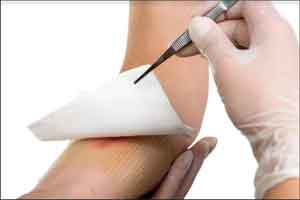- Home
- Editorial
- News
- Practice Guidelines
- Anesthesiology Guidelines
- Cancer Guidelines
- Cardiac Sciences Guidelines
- Critical Care Guidelines
- Dentistry Guidelines
- Dermatology Guidelines
- Diabetes and Endo Guidelines
- Diagnostics Guidelines
- ENT Guidelines
- Featured Practice Guidelines
- Gastroenterology Guidelines
- Geriatrics Guidelines
- Medicine Guidelines
- Nephrology Guidelines
- Neurosciences Guidelines
- Obs and Gynae Guidelines
- Ophthalmology Guidelines
- Orthopaedics Guidelines
- Paediatrics Guidelines
- Psychiatry Guidelines
- Pulmonology Guidelines
- Radiology Guidelines
- Surgery Guidelines
- Urology Guidelines
Coming Soon: Next generation dressing which stimulates tissue regeneration

Group of researchers at Kaunas University of Technology, Lithuania, are developing next-generation, sponge-like wound dressings with hyaluronic acid. Antimicrobial, antioxidant, anti-inflammatory wound dressings stimulate tissue regeneration and can be especially efficient in treating deep wounds that are difficult to heal.
Of total healthcare expenditures in the European Union, wound management makes up 2-4 percent. A single chronic wound can cost up to 10 thousand EUR to treat, and it is estimated that up to 1.5 percent of the EU population has one or more such wounds.
For a deep wound to heal successfully, tissue regeneration is extremely important. Development of next-generation wound dressings that assist this process is one of biggest challenges in tissue engineering. Kaunas University of Technology (KTU) researchers are developing sponge-like wound dressings based on hyaluronic acid, which is a well-researched polymer stimulating tissue regeneration and used in ophthalmology, bone regeneration and for other medical and cosmetic purposes.
"Hyaluronic acid is a natural polymer found in living organisms, which has anti-inflammatory properties and stimulates tissue regeneration. We are used to commercial hyaluronic acid based products, which usually are thick liquids or gels. Although quickly absorbed by the organism, in this form the polymer doesn't have the structure needed for tissue building," says Odeta Baniukaitiene, researcher at KTU Faculty of Chemical Technology.
Sponge-like wound dressings created at KTU have net structure, which is essential in developing wound dressings for tissue regeneration. Although biopolymers are often chosen for this purpose as they are compatible with biological systems, sponge-like wound dressings are mostly being made from alginate or collagen.
"We use freeze-drying technique to render hyaluronic acid in a sponge-like structure. The dressing fills in the wound, and serves as a structure for cells to adhere; the active compounds, which have antimicrobial, antioxidant, anti-inflammatory or tissue regeneration-stimulating qualities are in such a way fixed and carried through," says Baniukaitiene.
KTU researchers have built hyaluronic acid scaffolds that can be used for tissue regeneration. Collaborating with the Lithuanian University of Health Sciences, the scientists are testing the prototype in vitro with multiple cell types. According to researchers, the proof of concept stage research can take up a few more years.

Disclaimer: This site is primarily intended for healthcare professionals. Any content/information on this website does not replace the advice of medical and/or health professionals and should not be construed as medical/diagnostic advice/endorsement or prescription. Use of this site is subject to our terms of use, privacy policy, advertisement policy. © 2020 Minerva Medical Treatment Pvt Ltd